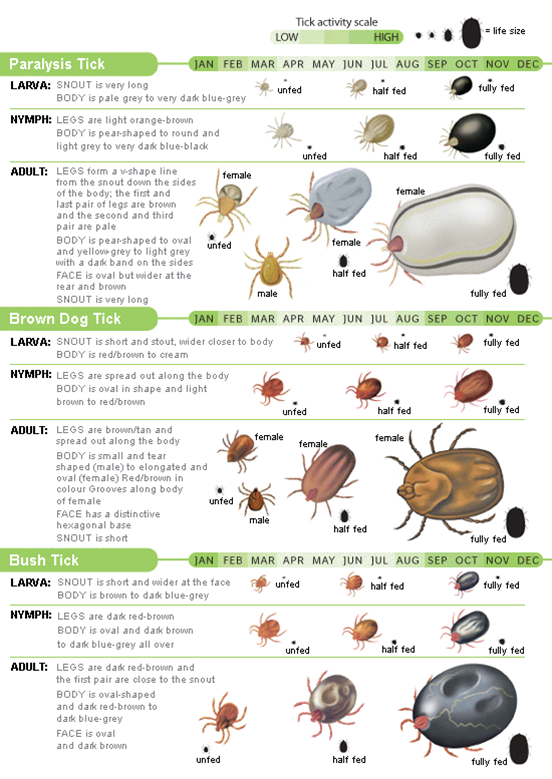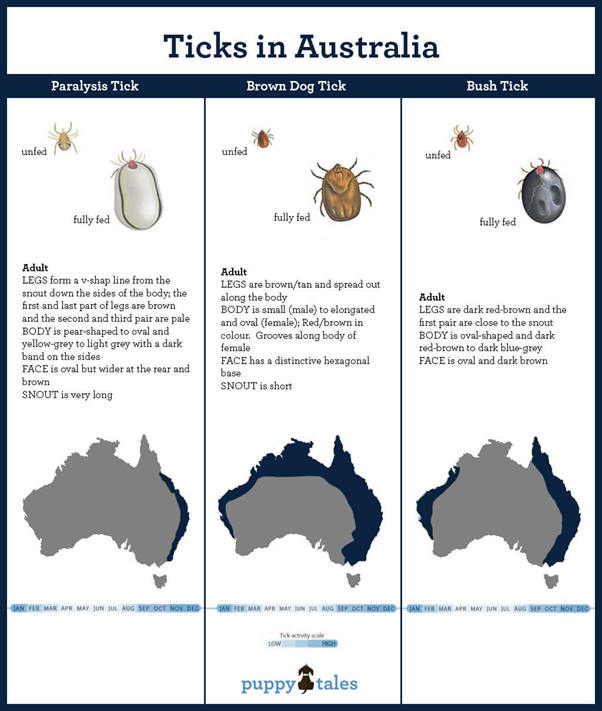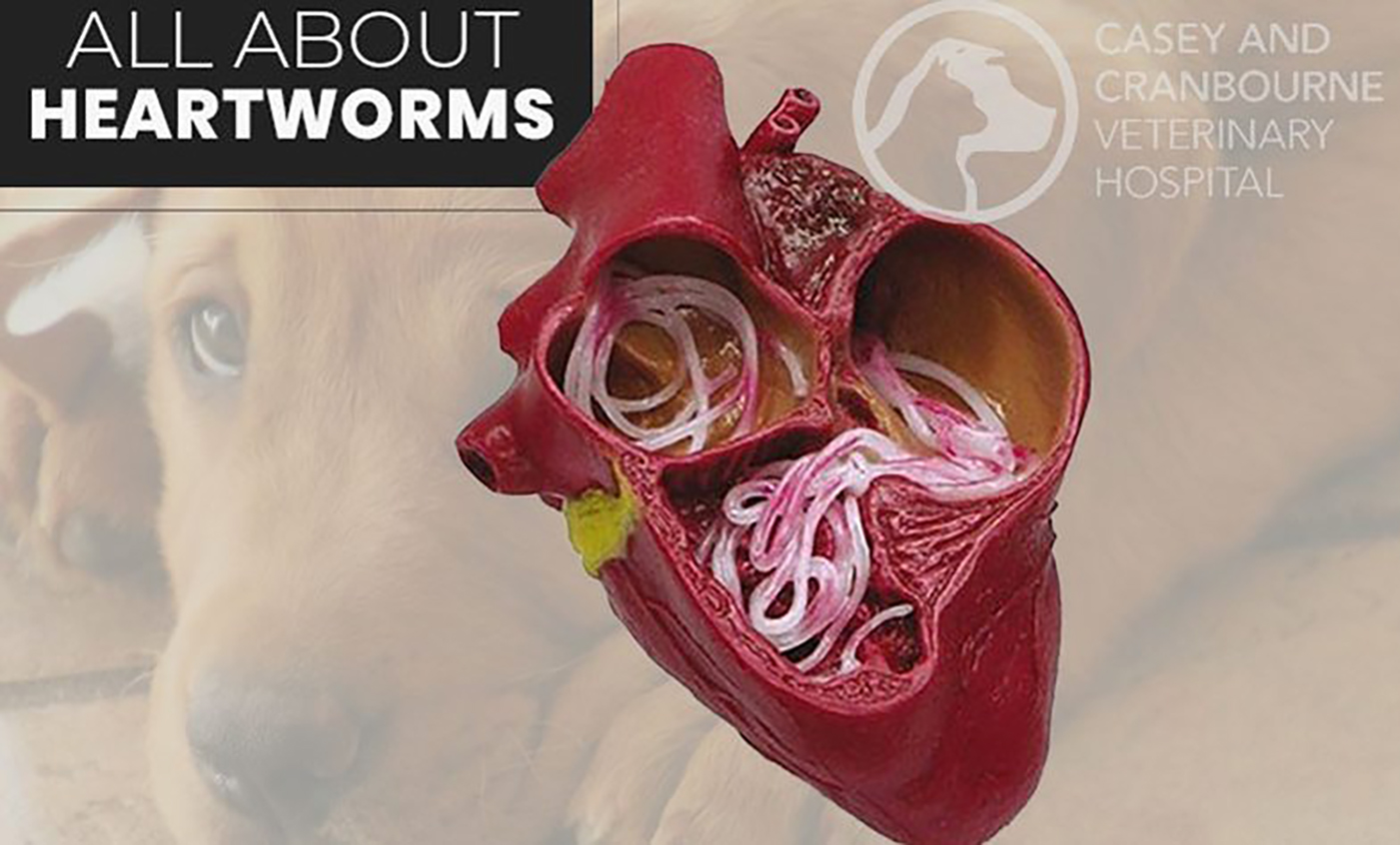Important information that could save your pet’s life.
Below is a chart of the different ticks we see in Australia. The most important one is the paralysis tick as this small tick can cause paralysis or even death of your beloved pet.

Ticks are blood-feeding external parasites.They are often found in tall grass, plants and bushes, where they will wait to attach to a passing host such as your dog. On dogs, ticks will often latch on to fur, and then work their way in until they find a prime piece of exposed skin. When they find exposed skin they will use their cutting mandibles to cut the skin and insert their feeding tube to feed on blood. While several tick species have been found in Australia, the paralysis tick (Ixodes Holocyclus) is the most dangerous to dogs (and cats) and can cause death. The paralysis tick injects holocyclic toxin into the animals blood stream that affects the neuromuscular junctions which are essential for muscle function. This results in weakness and paralysis of muscles. Paralysis of the respiratory muscles can result in death.
Where are Paralysis Ticks found?
Paralysis ticks are most prevalent between September to March in Australia (Summer) and they are most commonly found within around 20km of the Eastern Coastline. In Victoria, paralysis ticks are found along the coast as far south as Bairnsdale and Sale however they can find their way into camping equipment and clothing and can hitch a ride into suburban Melbourne. Over the past few summers, there has been the occasional reported case of tick paralysis in dogs in Melbourne who have not left their local suburban area and who’s owners have also not travelled to tick prone areas.
The chart below details the areas within Australia where the different ticks are found.

Signs of Tick Paralysis
The most common place to find a tick on a dog is towards the front of its body. The mouth and ears are hotspots, as well the armpits of dogs and between the toes and paw pads.
The paralysis tick injects holocyclic toxin into the animals blood stream that affects the neuromuscular junctions which are essential for muscle function.
This toxin causes muscle weakness and paralysis, which typically affects the hindlegs first, then progresses to the forelegs, digestive and respiratory muscles. Overall this may lead to wobbliness, breathing difficulties, coughing or grunting, dilated pupils and difficulties blinking, difficulties swallowing and digesting food, excess salivation, retching and vomiting.

You may not see all of these symptoms and often dogs initially present to the clinic just with weakness of the hind legs or just retching.
Tick Paralysis Diagnosis
Ticks are attracted to Carbon Dioxide which is produced by breathing, therefore 75% of ticks are found on the front legs and neck. Occasionally it can take multiple searches to find the offending tick! They can burrow deeply into the fur and often we will recommend a full body shave to ensure we have found every possible tick. This is very important (and can be life-saving). If we recommends shaving, don’t worry about the cosmetics – it may be life or death!
Tick Paralysis Prognosis
Tick paralysis can be severe. Unfortunately, the tick antitoxin that is available to vets, only binds to any free toxin in the blood stream. It does nothing to the toxin that has already bound. This means that even after the tick anti-toxin has been given, the signs of tick paralysis can get worse. This means that 5% of cases are fatal regardless of treatment, usually due to respiratory compromise or aspiration pneumonia (where food is inhaled into the lungs due to dysfunction of the muscles controlling swallowing). Older dogs are often more severely affected.
Tick Prevention
The best prevention is to have you pet on a treatment that protects then against ticks. For dogs, we recommend either Simparica or Simparica Trio (monthly chew), Bravecto (3 monthly chew) or Bravecto spot on (lasts 6 months). For cats, we recommend Revolution Plus (monthly spot on) or Bravecto Plus (3 monthly spot on).
A simple tick prevention treatment can be lifesaving for your pet so please contact the clinic today to ask about the best option for your beloved pets.
The best prevention is to have your pet on a treatment that protects them against ticks. For dogs, we recommend either Simparica or Simparica Trio (monthly chew), Bravecto (3 monthly chew) or Bravecto spot on (lasts 6 months). For cats we recommend Revolution Plus (monthly spot on) or Bravecto Plus (3 monthly spot on) for cats.



